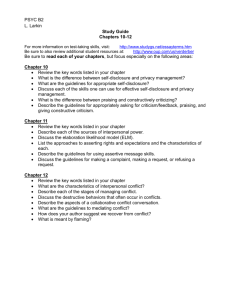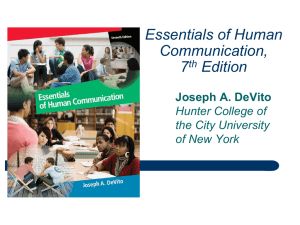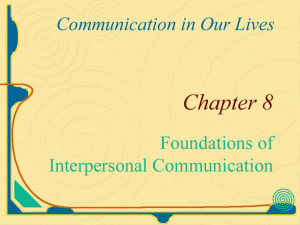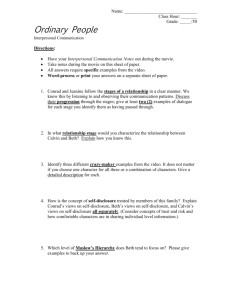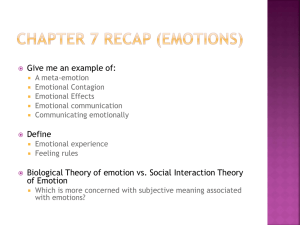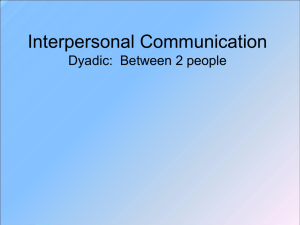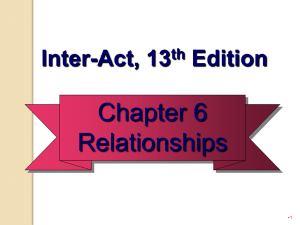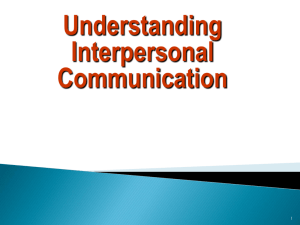File
advertisement
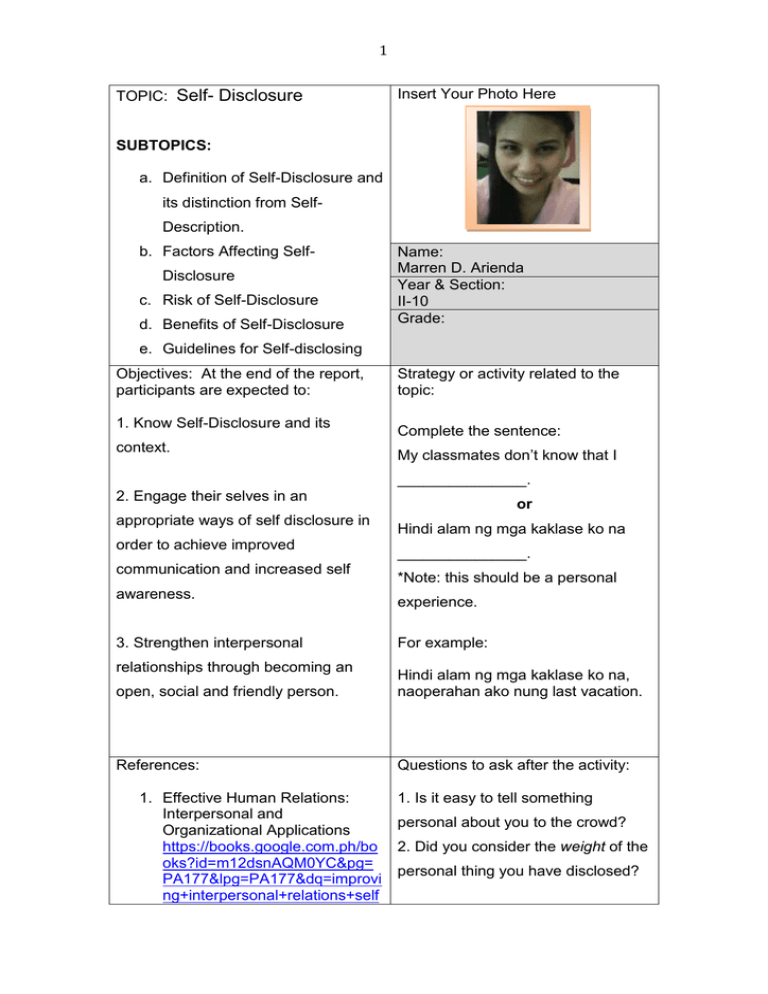
1 TOPIC: Self- Disclosure Insert Your Photo Here SUBTOPICS: a. Definition of Self-Disclosure and its distinction from SelfDescription. b. Factors Affecting SelfDisclosure c. Risk of Self-Disclosure d. Benefits of Self-Disclosure Name: Marren D. Arienda Year & Section: II-10 Grade: e. Guidelines for Self-disclosing Objectives: At the end of the report, participants are expected to: 1. Know Self-Disclosure and its context. Strategy or activity related to the topic: Complete the sentence: My classmates don’t know that I _______________. 2. Engage their selves in an appropriate ways of self disclosure in order to achieve improved communication and increased self awareness. 3. Strengthen interpersonal relationships through becoming an or Hindi alam ng mga kaklase ko na _______________. *Note: this should be a personal experience. For example: open, social and friendly person. Hindi alam ng mga kaklase ko na, naoperahan ako nung last vacation. References: Questions to ask after the activity: 1. Effective Human Relations: Interpersonal and Organizational Applications https://books.google.com.ph/bo oks?id=m12dsnAQM0YC&pg= PA177&lpg=PA177&dq=improvi ng+interpersonal+relations+self 1. Is it easy to tell something personal about you to the crowd? 2. Did you consider the weight of the personal thing you have disclosed? 2 +disclosure&source=bl&ots=cXt iGHtSwD&sig=EUY7uQqB6aY GYlFMZrG-m7TmMo&hl=en&sa=X&ei=5Uh xVcvrGsGoogTYsICIBQ&ved=0 CDoQ6AEwBA#v=onepage&q= improving%20interpersonal%20 relations%20self%20disclosure &f=false 3. Why do you think is it necessary to disclose personal matters to people although you know there might be risk/vulnerability? 2. Self- Disclosure http://www.slideshare.net/juspc h/self-disclosure-10461665 3. Self-Disclosure and Interpersonal Relationship http://2012books.lardbucket.org /books/a-primer-oncommunication-studies/s06-04self-disclosure-andinterperso.html Self-Disclosure The intentional sharing of personal information about oneself.. Self-Disclosure Self-Description Often involves some degree of risk You reveal private, personal information that cannot be acquired from another source. Involves disclosure of nonthreatening information – age – favorite food – where you went to school Information that can usually be acquired in some other way 3 Factors Affecting Self-Disclosure 1. Who We Are – our personality ex. introverted/extroverted, confidence - the more social a person is, the more likely they will self-disclose 2. Culture – different cultures have different views on self-disclosure and the topics you disclose about 3. Gender – the male and female psyche are inherently different ex. women tend to disclose more than men 4. The Listener – the no. of listeners (generally, the more listeners, the less willing to self-disclose) - The relationship with the listener/listeners - Liking those with whom you self-disclose - The dyadic effect 5. Topic – certain topics are more “taboo” than others 6. Channel of Communication – actually affects our willingness to selfdisclose Risks of Self Disclosure a. Revealing too much -“knowledge is power” -people can use information for other purposes b. Rejection/Loss of Self-Confidence - people might not support or like what you disclose about yourself c. Material Loss - sensitive information, if revealed, can cause a person to lose his job, status, ranking, etc. Benefits from Self-Disclosure 1. Increased Accuracy in Communication • • • People cannot read minds Take the guess work out of the process Reporting both facts and feelings improves accuracy 2. Reduction of stress Emphasis on privacy and concealment of feelings creates stress Sharing inner thoughts and feelings usually reduces stress Stress symptoms can include o high blood pressure – perspiration 4 o decline in immunization – rapid breathing 3. Increased self-awareness Self-awareness o The ability to recognize and understand your moods, emotions, drives and their effect on others o The foundation on which self-development is built Increases as you receive feedback from others 4. Stronger relationships When two people engage in an open dialogue, they often develop a high regard for each other’s views Enhances awareness of common interests and concerns 5. Repair Damaged Relationships • • • • • Many relationships are unnecessarily strained People refuse to talk about real or imagined problems Self-disclosure can be an excellent way to repair damaged relationships The Art of Apologizing - A sincere apology has healing power - Can improve communication in the future - Apologize if actions caused hurt feelings, anger, or deep-seated ill will - Apologize in private so that feelings can be exchanged in relative comfort - Apologize completely—should include: - Regret - Responsibility - Remedy - Avoid the “I am sorry for what happened, but you shouldn’t have….” The Art of Forgiveness - To forgive means to give up resentment and anger - Forgiveness heals, and liberates energy and creativity Guidelines for Self-disclosing Making Disclosures (RAB-OP) Reason – examine own motivations Appropriateness – is the context, relationship, time and place appropriate? Burdens – consider the burdens the disclosure might cause you or the listener Other Person - give others a chance to reciprocate with their own disclosures 5 Responding to Disclosures (HELBR) Hush – keep disclosures confidential Encourage – express support for the person Listen – listen actively, with empathy and with an open mind (don’t) Blackmail – don’t use disclosure against the other Respond – reciprocate by also disclosing Resisting Pressure to Self-Disclose (RIA) Resist – don’t get pushed into saying something you don’t want to Indirect – change the topic and avoid questions that prompt you to self-disclose Assert Position – directly but respectfully refuse “Vulnerability is often seen as a weakness; it’s actually a sign of strength. People who are genuinely open and transparent prove that they have the confidence and self-esteem to allow others to see them as they really are, warts and all” – Patrick Lencion
